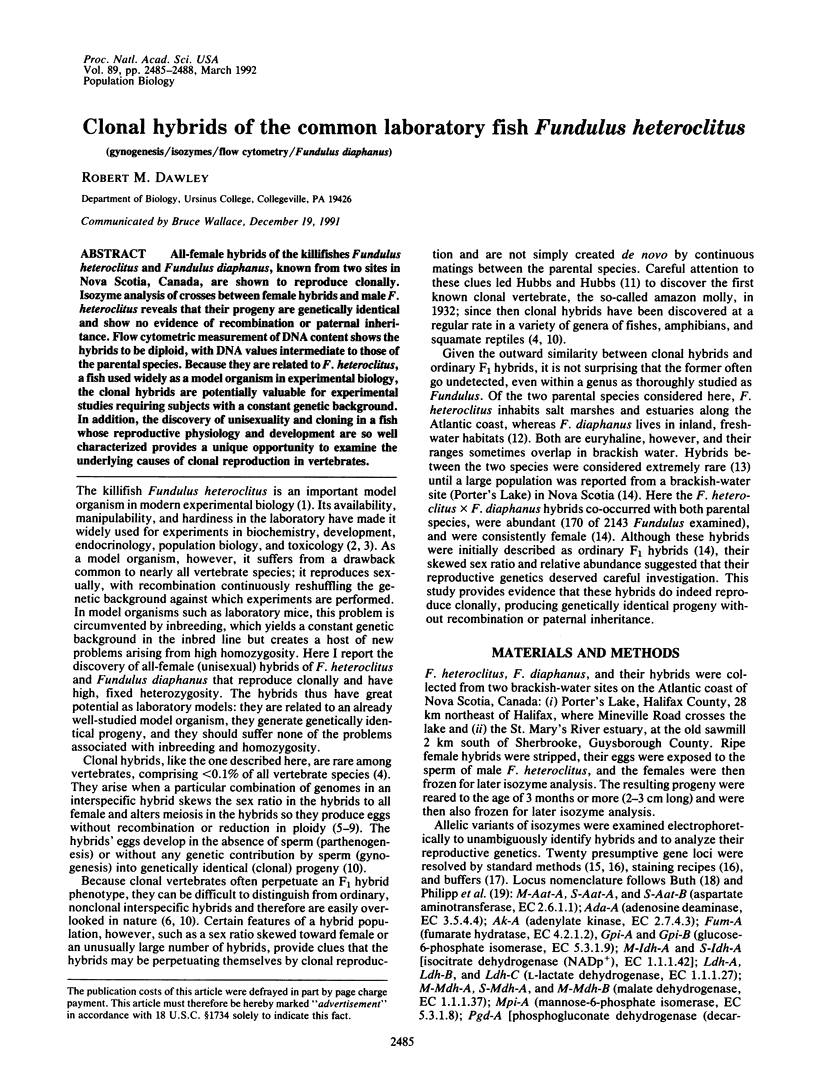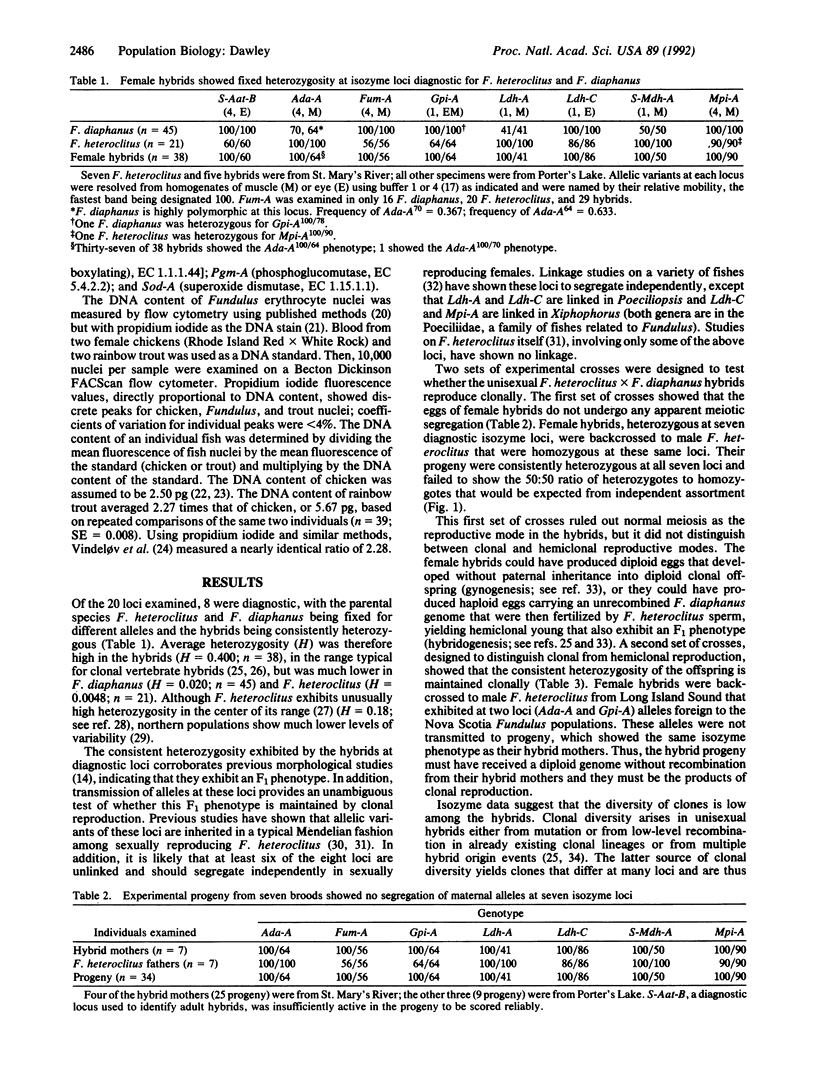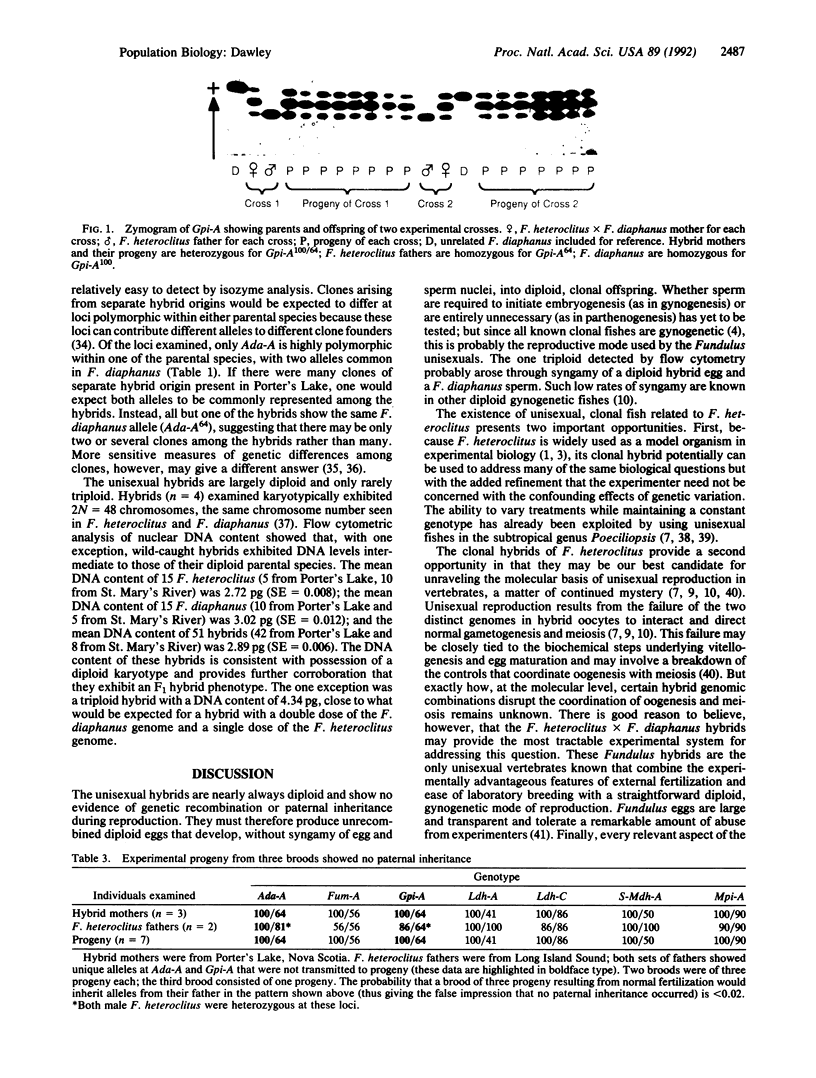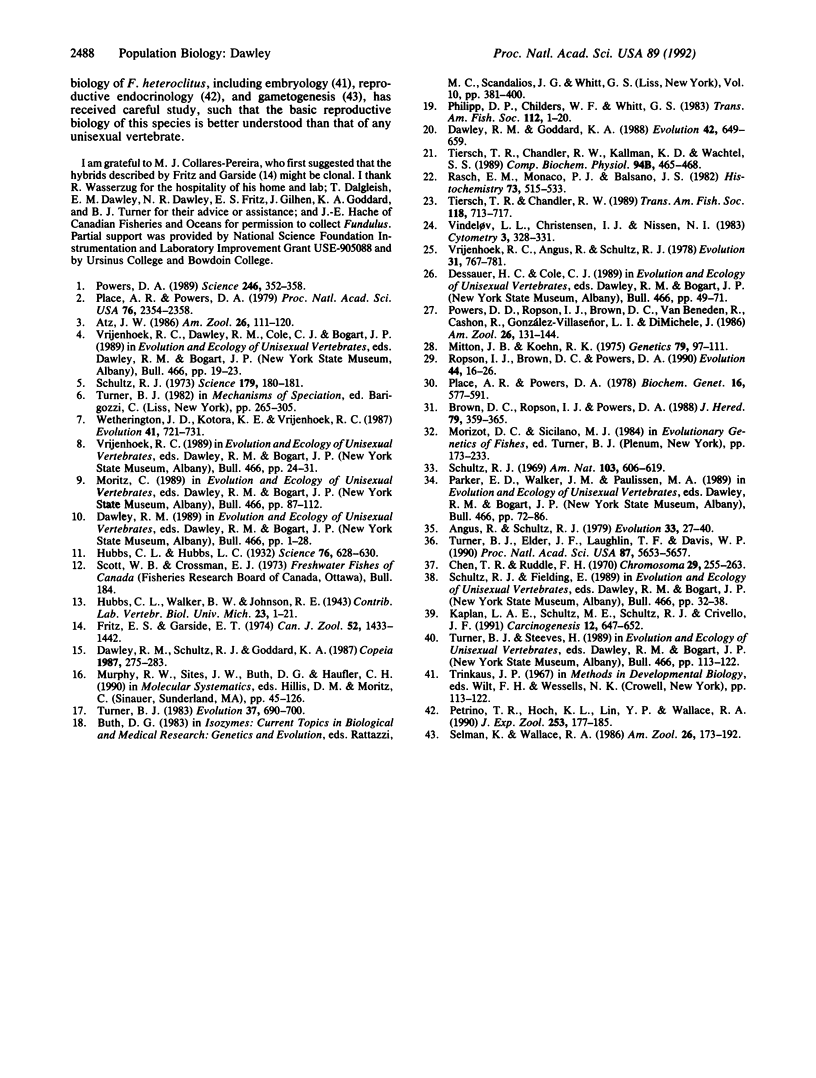Abstract
All-female hybrids of the killifishes Fundulus heteroclitus and Fundulus diaphanus, known from two sites in Nova Scotia, Canada, are shown to reproduce clonally. Isozyme analysis of crosses between female hybrids and male F. heteroclitus reveals that their progeny are genetically identical and show no evidence of recombination or paternal inheritance. Flow cytometric measurement of DNA content shows the hybrids to be diploid, with DNA values intermediate to those of the parental species. Because they are related to F. heteroclitus, a fish used widely as a model organism in experimental biology, the clonal hybrids are potentially valuable for experimental studies requiring subjects with a constant genetic background. In addition, the discovery of unisexuality and cloning in a fish whose reproductive physiology and development are so well characterized provides a unique opportunity to examine the underlying causes of clonal reproduction in vertebrates.
Full text
PDF



Images in this article
Selected References
These references are in PubMed. This may not be the complete list of references from this article.
- Chen T. R., Ruddle R. H. A chromosome study of four species and a hybrid of the killifish genus Fundulus (Cyprinodontidae). Chromosoma. 1970;29(3):255–267. doi: 10.1007/BF00325942. [DOI] [PubMed] [Google Scholar]
- Fritz E. S., Garside E. T. Identification and description of hybrids of Fundulus heteroclitus and F. diaphanus (Pisces: Cyprinodontidae) from Porters Lake, Nova Scotia, with evidence for absence of backcrossing. Can J Zool. 1974 Dec;52(12):1433–1442. doi: 10.1139/z74-184. [DOI] [PubMed] [Google Scholar]
- Hubbs C. L., Hubbs L. C. APPARENT PARTHENOGENESIS IN NATURE, IN A FORM OF FISH OF HYBRID ORIGIN. Science. 1932 Dec 30;76(1983):628–630. doi: 10.1126/science.76.1983.628. [DOI] [PubMed] [Google Scholar]
- Kaplan L. A., Schultz M. E., Schultz R. J., Crivello J. F. Nitrosodiethylamine metabolism in the viviparous fish Poeciliopsis: evidence for the existence of liver P450pj activity and expression. Carcinogenesis. 1991 Apr;12(4):647–652. doi: 10.1093/carcin/12.4.647. [DOI] [PubMed] [Google Scholar]
- Mitton J. B., Koehn R. K. Genetic organization and adaptive response of allozymes to ecological variables in Fundulus heteroclitus. Genetics. 1975 Jan;79(1):97–111. doi: 10.1093/genetics/79.1.97. [DOI] [PMC free article] [PubMed] [Google Scholar]
- Place A. R., Powers D. A. Genetic bases for protein polymorphism in Fundulus heteroclitus (L.).I. Lactate dehydrogenase (Ldh-B), malate dehydrogenase (Mdh-A), glucosephosphate isomerase (Gpi-B), and phosphoglucomutase (Pgm-A). Biochem Genet. 1978 Jun;16(5-6):577–591. doi: 10.1007/BF00484221. [DOI] [PubMed] [Google Scholar]
- Place A. R., Powers D. A. Genetic variation and relative catalytic efficiencies: lactate dehydrogenase B allozymes of Fundulus heteroclitus. Proc Natl Acad Sci U S A. 1979 May;76(5):2354–2358. doi: 10.1073/pnas.76.5.2354. [DOI] [PMC free article] [PubMed] [Google Scholar]
- Powers D. A. Fish as model systems. Science. 1989 Oct 20;246(4928):352–358. doi: 10.1126/science.2678474. [DOI] [PubMed] [Google Scholar]
- Rasch E. M., Monaco P. J., Balsano J. S. Cytophotometric and autoradiographic evidence for functional apomixis in a gynogenetic fish, Poecilia formosa and its related, triploid unisexuals. Histochemistry. 1982;73(4):515–533. doi: 10.1007/BF00493366. [DOI] [PubMed] [Google Scholar]
- Schultz R. J. Unisexual fish: laboratory synthesis of a "species". Science. 1973 Jan 12;179(4069):180–181. doi: 10.1126/science.179.4069.180. [DOI] [PubMed] [Google Scholar]
- Sittig D. F., Gardner R. M., Morris A. H., Wallace C. J. Clinical evaluation of computer-based respiratory care algorithms. Int J Clin Monit Comput. 1990 Jul;7(3):177–185. doi: 10.1007/BF02915583. [DOI] [PubMed] [Google Scholar]
- Tiersch T. R., Chandler R. W., Kallman K. D., Wachtel S. S. Estimation of nuclear DNA content by flow cytometry in fishes of the genus Xiphophorus. Comp Biochem Physiol B. 1989;94(3):465–468. doi: 10.1016/0305-0491(89)90182-x. [DOI] [PubMed] [Google Scholar]
- Turner B. J., Elder J. F., Jr, Laughlin T. F., Davis W. P. Genetic variation in clonal vertebrates detected by simple-sequence DNA fingerprinting. Proc Natl Acad Sci U S A. 1990 Aug;87(15):5653–5657. doi: 10.1073/pnas.87.15.5653. [DOI] [PMC free article] [PubMed] [Google Scholar]
- Vindeløv L. L., Christensen I. J., Nissen N. I. Standardization of high-resolution flow cytometric DNA analysis by the simultaneous use of chicken and trout red blood cells as internal reference standards. Cytometry. 1983 Mar;3(5):328–331. doi: 10.1002/cyto.990030504. [DOI] [PubMed] [Google Scholar]



